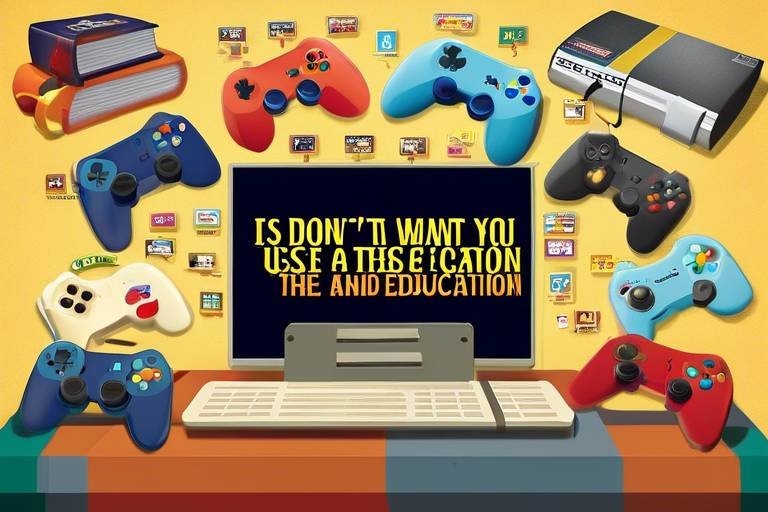Preparing Kids for a Future in Technology
In today's fast-paced world, technology is not just an accessory; it's a fundamental part of our daily lives. As we look ahead, it's clear that the future will be dominated by technological advancements, and preparing our children for this reality is more important than ever. But how do we equip them with the skills and knowledge necessary to thrive in a technology-driven world? The answer lies in a combination of early exposure, hands-on learning experiences, and fostering critical thinking skills. By taking proactive steps now, we can ensure that our kids not only keep up with the technological curve but also become innovators and leaders in their fields.
Imagine trying to learn a new language as an adult—it's tough, right? Now, think about how much easier it is for children to pick up languages when they're young. The same principle applies to technology. Introducing children to technology at a young age fosters interest and familiarity, paving the way for future learning and innovation in various fields. Early exposure helps demystify complex concepts and makes technology feel like a natural part of their world. Whether it's through simple coding games, robotics kits, or interactive apps, the goal is to spark curiosity and creativity. The earlier they start, the more comfortable they'll be navigating this digital landscape.
There's a saying that goes, "Tell me and I forget, teach me and I remember, involve me and I learn." This couldn't be truer when it comes to technology. Engaging children in hands-on projects allows them to apply theoretical knowledge practically, enhancing their understanding and retention of technological concepts. For instance, building a simple robot or creating a video game can transform abstract ideas into tangible experiences. These projects not only solidify their learning but also encourage teamwork and communication skills. Moreover, when kids see their ideas come to life, it boosts their confidence and fuels their passion for technology.
One of the most valuable skills children can learn today is coding. Teaching kids coding through interactive platforms can ignite their creativity and problem-solving abilities, crucial skills in today's digital landscape. Coding isn't just about writing lines of code; it's about learning how to think logically and tackle challenges systematically. Kids who learn to code often find themselves better equipped to handle various subjects in school, from math to science. It’s like giving them a superpower that they can use to create, innovate, and solve problems.
When it comes to coding languages, not all are created equal, especially for beginners. Languages like Scratch and Python are accessible and engaging for young minds. Scratch uses a visual programming interface, allowing kids to drag and drop code blocks to create animations and games. On the other hand, Python, known for its simplicity and readability, serves as a fantastic introduction to text-based coding. By starting with these languages, children can build a solid foundation before moving on to more complex programming languages.
Fortunately, there are countless online platforms that offer free coding tutorials and games designed specifically for children. Websites like Code.org, Codecademy, and Khan Academy provide interactive lessons that make learning to code fun and engaging. These resources create a supportive environment for learning and experimentation, allowing kids to progress at their own pace. Plus, many of these platforms foster a sense of community where young coders can share their projects and collaborate with peers.
In addition to technical skills, fostering critical thinking skills in children prepares them to analyze problems effectively and develop innovative solutions in technology and beyond. Critical thinking is like a mental toolkit that enables kids to approach challenges with a problem-solving mindset. By encouraging them to ask questions, evaluate information, and consider multiple perspectives, we are equipping them to tackle the complexities of the future. Activities such as puzzles, strategy games, and even discussions about current events can stimulate their critical thinking abilities.
Integrating technology into everyday activities helps children understand its relevance and applications, making learning more relatable and enjoyable. For example, using educational apps during family game nights can turn screen time into productive learning experiences. It's all about finding that balance and making technology a seamless part of their lives. When children see technology as a tool for creativity and expression, they are more likely to engage with it positively.
There are countless educational apps available that combine learning with play, reinforcing concepts while keeping children engaged and motivated. Apps like Prodigy Math and Duolingo turn learning into an adventure, encouraging kids to explore new subjects in a fun way. By incorporating these tools into their daily routines, parents can help their children develop a love for learning that lasts a lifetime.
Establishing a home environment that encourages exploration and experimentation with technology can significantly enhance children's learning experiences and confidence. This could mean setting up a dedicated space for tech projects, providing access to various gadgets, or even participating in family tech challenges. The more children feel empowered to explore and create, the more likely they are to develop a passion for technology that could lead to future career opportunities.
- What age should I start introducing technology to my child? It's best to start introducing technology around preschool age, focusing on interactive and educational tools.
- How can I ensure my child is safe online? Establish clear guidelines for internet use, utilize parental controls, and educate your child about online safety.
- Are there any offline activities that promote tech skills? Absolutely! Building models, engaging in science experiments, and playing strategy games can all foster tech-related skills.

The Importance of Early Exposure
In today's fast-paced world, where technology is evolving at lightning speed, early exposure to tech concepts is more crucial than ever. Imagine a world where your child can navigate through complex software or create their own video game before they even hit their teenage years! Sounds exciting, right? This is the power of introducing technology to children at an early age. It not only sparks their curiosity but also lays a solid foundation for future learning and innovation.
When children are introduced to technology early on, they begin to see it as a tool for creativity rather than just a means of entertainment. This shift in perspective can be transformative. For instance, a child who learns to code at a young age doesn't just learn how to write commands; they learn how to think logically and solve problems creatively. Early exposure helps demystify technology, making it less intimidating and more approachable. Instead of viewing tech as a complex puzzle, kids start to see it as a canvas for their ideas.
Moreover, early exposure can lead to a greater interest in STEM (Science, Technology, Engineering, and Mathematics) fields. Research suggests that children who engage with technology early are more likely to pursue careers in these areas. This is particularly important as the demand for tech-savvy professionals continues to grow. Consider the following benefits of early exposure to technology:
- Increased Confidence: Kids gain confidence in their abilities, knowing they can create and innovate.
- Enhanced Problem-Solving Skills: They learn to approach challenges with a solution-oriented mindset.
- Better Adaptability: Early exposure makes it easier for them to adapt to new tools and technologies as they emerge.
Incorporating technology into play and learning can be as simple as using educational apps or engaging in coding games. The key is to make it fun! When children associate technology with play, they are more likely to embrace it. Additionally, parents and educators can play a pivotal role by providing resources and opportunities for exploration. Whether it's through coding clubs, robotics workshops, or simply encouraging kids to tinker with gadgets, the possibilities are endless.
Ultimately, the goal is to create an environment where technology is seen as an integral part of life. This approach not only prepares children for the future but also equips them with the skills needed to thrive in an increasingly digital world. So, why wait? Start introducing your kids to technology today and watch them flourish!

Hands-On Learning Experiences
When it comes to preparing kids for a future in technology, are invaluable. Think of it as giving children a toolbox filled with the instruments they need to build their understanding of the tech world. Instead of simply reading about technology, engaging in practical, hands-on projects allows children to apply theoretical knowledge in real-world scenarios. This not only enhances their understanding but also significantly boosts retention of technological concepts. Imagine trying to learn to ride a bike by just reading about it versus actually getting on the bike and pedaling; the difference is astounding!
One of the most exciting aspects of hands-on learning is the opportunity for creativity. For instance, when kids are tasked with building a simple robot or creating a mobile app, they are not just following instructions; they are solving problems, experimenting, and innovating. This process can lead to a deeper interest in technology as they see firsthand how their ideas come to life. Moreover, these experiences often foster teamwork and collaboration, as many projects require kids to work together to achieve a common goal.
To illustrate the impact of hands-on learning, consider the following table that compares traditional learning methods with hands-on approaches:
| Learning Method | Engagement Level | Retention Rate | Skill Development |
|---|---|---|---|
| Traditional Learning | Low | 30% | Limited |
| Hands-On Learning | High | 70% | Enhanced |
As you can see, the difference is striking! Hands-on learning not only keeps kids engaged but also increases their retention rate and skill development significantly. So, how can parents and educators incorporate more of these enriching experiences into children's lives? Here are a few ideas:
- DIY Projects: Encourage kids to take on do-it-yourself projects, whether it's building a birdhouse or creating a simple video game.
- Workshops and Classes: Look for local workshops or online classes that focus on technology, robotics, or coding.
- Science Fairs: Encourage participation in science fairs where kids can showcase their projects and learn from peers.
Incorporating these hands-on experiences into children's learning can spark a lifelong interest in technology. By allowing them to explore, create, and innovate, we are not just teaching them how to use technology; we are preparing them to become the next generation of tech innovators.
Q: What age should children start hands-on technology projects?
A: Children can start engaging in hands-on technology projects as early as age 5, depending on their interest and maturity level. Simple projects can be tailored to their age and skill set.
Q: How can I find resources for hands-on learning?
A: There are numerous online platforms, community centers, and libraries that offer resources and workshops for hands-on learning in technology. Websites like Code.org and Khan Academy are great starting points.
Q: Can hands-on learning be done at home?
A: Absolutely! Many hands-on projects can be done at home using everyday materials. Encourage creativity and exploration by setting up a dedicated space for these activities.

Building Coding Skills
In today's digital age, coding skills are becoming as essential as reading and writing. Imagine being able to create your own video game or design a website from scratch! This is not just a dream but a reality that can be achieved through early exposure to coding. By teaching kids to code, we are not only equipping them with a valuable skill set but also igniting their creativity and problem-solving abilities. Coding is like learning a new language; it opens doors to a world of possibilities. When children learn to code, they learn how to think logically, break down problems into manageable parts, and approach challenges with a critical mindset.
One of the best ways to introduce coding to children is through interactive platforms. These platforms make learning fun and engaging, turning what could be a daunting subject into an exciting adventure. Kids can create their own games or animations, which not only enhances their understanding of coding concepts but also boosts their confidence. It’s like giving them a magic wand that allows them to bring their ideas to life!
Moreover, many coding platforms use a visual programming language, which simplifies the coding process. For instance, languages like Scratch allow kids to drag and drop code blocks to create programs. This visual approach is particularly beneficial for younger learners, as it helps them grasp the fundamentals of coding without getting bogged down by complex syntax. As they progress, they can transition to more advanced languages like Python, which is user-friendly and widely used in the industry.
Here are some popular coding languages that are perfect for kids:
- Scratch: Great for beginners, Scratch uses a block-based coding system that is easy to understand.
- Python: Known for its simplicity, Python is an excellent choice for kids ready to take the next step in coding.
- JavaScript: This language is essential for web development and can be fun for kids interested in creating interactive websites.
To further support children's coding journey, numerous online resources are available. Websites like Code.org and Khan Academy offer free tutorials and games tailored for kids. These platforms create a supportive environment where children can learn at their own pace, experiment with code, and even collaborate with peers on projects. Think of it as a playground where they can explore, learn, and grow without the fear of making mistakes.
In conclusion, building coding skills in children is not just about teaching them to program; it's about fostering a mindset that encourages innovation and creativity. By making coding accessible and enjoyable, we prepare our children for a future where technology plays a central role in every aspect of life. So, let’s empower the next generation with the tools they need to succeed in a tech-driven world!
1. At what age should I start teaching my child to code?
Most experts suggest introducing coding concepts as early as age 5, using visual programming languages like Scratch. The key is to make it fun and engaging.
2. What resources are best for beginners?
Websites like Code.org, Scratch, and Khan Academy offer excellent resources for beginners, including tutorials and interactive games.
3. Is coding difficult for kids to learn?
Coding can be challenging, but with the right resources and a supportive environment, kids can learn to code in a fun and engaging way.
4. How can coding benefit my child's future?
Coding teaches valuable skills such as critical thinking, problem-solving, and creativity, all of which are essential in today's technology-driven job market.

Popular Coding Languages for Kids
When it comes to teaching kids how to code, choosing the right programming language is crucial. The goal is to make learning both fun and engaging. Two of the most popular languages that fit this bill are Scratch and Python. Let's dive into why these languages are so well-suited for young learners.
Scratch is a visual programming language that allows children to create animations, games, and interactive stories by snapping together blocks of code. Its intuitive drag-and-drop interface makes it incredibly user-friendly, even for the youngest coders. Kids can see the results of their coding efforts immediately, which provides instant gratification and encourages them to experiment. It's like building with LEGO blocks, but instead of physical bricks, they're using colorful code blocks to bring their ideas to life.
On the other hand, Python is a text-based programming language that's known for its simplicity and readability. While it may seem a bit daunting at first, Python's straightforward syntax helps kids transition from visual programming to more complex coding concepts smoothly. It's like learning to ride a bike with training wheels; once they get the hang of it, they can take off and explore new terrains. Python is not only versatile—used in web development, data analysis, artificial intelligence, and more—but it's also widely regarded in the industry, making it a valuable skill for kids as they prepare for future careers.
To further illustrate the differences and benefits of these languages, here's a quick comparison:
| Language | Type | Best For | Age Group |
|---|---|---|---|
| Scratch | Visual | Creative projects, animations, games | 5-12 years |
| Python | Text-based | General programming, web development, data science | 10+ years |
Moreover, there are numerous online platforms that offer free resources and tutorials for both Scratch and Python, making it easy for kids to dive into coding from the comfort of their homes. Websites like Code.org, Scratch.mit.edu, and Codecademy provide interactive lessons and challenges that can spark a child's interest in technology.
In conclusion, introducing children to coding through languages like Scratch and Python not only equips them with essential skills but also fuels their creativity and problem-solving abilities. These languages serve as gateways into the exciting world of technology, preparing them for a future where coding is an invaluable asset. So, why not start today? Encourage your child to explore these languages and watch their potential unfold!
- What age should my child start learning coding? - Many kids can start as early as five years old with visual programming languages like Scratch.
- Is coding difficult for kids to learn? - Not at all! With the right resources and a fun approach, coding can be very accessible and enjoyable for children.
- Can coding help my child in other subjects? - Yes! Coding enhances problem-solving skills and logical thinking, which are beneficial in math and science.
- Are there offline resources for teaching kids coding? - Absolutely! Many books and coding kits are available that provide hands-on learning experiences without needing a computer.

Online Coding Resources
In today’s digital age, the internet is brimming with tailored specifically for children. These platforms not only teach coding but also make the learning process engaging and fun. Imagine your child, sitting at the computer, eyes wide with excitement as they create their own games or animations! This is the magic of online coding resources. They provide an interactive environment where kids can learn at their own pace, experiment, and most importantly, unleash their creativity.
One of the most popular platforms is Scratch, developed by MIT. Scratch allows children to create interactive stories, games, and animations using a visual programming language. It’s incredibly user-friendly, making it perfect for beginners. Kids can drag and drop code blocks to bring their ideas to life, which helps them grasp fundamental programming concepts without feeling overwhelmed. Scratch also has a vibrant community where kids can share their projects and gain inspiration from others, fostering a sense of collaboration and innovation.
Another fantastic resource is Code.org, which offers a variety of coding courses aimed at different age groups. Their courses are designed to be engaging, featuring popular characters from games and movies that children love. For instance, kids can learn coding basics through fun games and challenges inspired by Angry Birds or Frozen. This gamified approach not only keeps kids entertained but also motivates them to continue learning.
For those looking for a more structured learning path, platforms like Khan Academy provide comprehensive coding courses that cover everything from basic programming to advanced computer science topics. The beauty of Khan Academy lies in its flexibility; children can learn at their own pace, revisit challenging concepts, and track their progress through interactive exercises. This self-directed learning model is perfect for nurturing independence and critical thinking.
Additionally, Codecademy offers a wide range of coding languages, including Python, JavaScript, and HTML/CSS. While it’s more geared towards older kids and teens, the platform provides an excellent stepping stone for those ready to dive deeper into the world of programming. With interactive lessons and real-time feedback, learners can build practical skills that will serve them well in future endeavors.
To give you a quick overview, here’s a table summarizing some of the best online coding resources for kids:
| Resource | Age Group | Features |
|---|---|---|
| Scratch | 8+ | Visual programming, community sharing |
| Code.org | 4-18 | Gamified lessons, popular character themes |
| Khan Academy | 8+ | Comprehensive courses, self-paced learning |
| Codecademy | 13+ | Interactive lessons, multiple programming languages |
In conclusion, the world of online coding resources is vast and filled with opportunities for children to learn and grow. By providing access to these platforms, parents can help their kids develop essential skills that will be invaluable in a technology-driven future. So why wait? Dive into these resources together and watch your child's passion for technology blossom!
Q: What age should I start teaching my child coding?
A: It's never too early to start! Many resources cater to children as young as 4 years old. Platforms like Scratch are perfect for introducing coding concepts to younger kids.
Q: Do I need to know coding to help my child?
A: Not at all! Many online resources are designed to guide both parents and children through the learning process, making it easy for anyone to get involved.
Q: How much time should my child spend on coding?
A: It's best to keep sessions short and engaging, around 30 minutes to an hour, depending on your child's interest level. The key is to make it fun!
Q: Can coding really benefit my child in the future?
A: Absolutely! Coding teaches critical thinking, problem-solving, and creativity, skills that are essential in many careers today.

Encouraging Critical Thinking
In today's fast-paced, technology-driven world, critical thinking has emerged as an essential skill for children. It's not just about knowing the answers; it's about asking the right questions and analyzing situations from multiple angles. Imagine teaching your child to be a detective, piecing together clues to solve a mystery. That’s the essence of critical thinking! By nurturing this skill, we prepare them to tackle challenges head-on, whether in tech or any other field.
So, how can we effectively instill critical thinking in our kids? One of the most effective methods is through problem-solving activities. These activities encourage children to think outside the box and explore various solutions to a problem. For instance, when faced with a simple puzzle, instead of jumping straight to the solution, ask them to consider different strategies. This not only enhances their analytical skills but also fosters a sense of independence and confidence.
Moreover, engaging children in discussions about everyday issues can significantly bolster their critical thinking abilities. Ask them open-ended questions like, “What would you do if…?” or “Why do you think that happened?” Such inquiries compel children to articulate their thoughts, analyze scenarios, and justify their reasoning. It’s like giving them a mini-debate stage right at home!
Another fantastic approach is to integrate technology into these discussions. For example, when using educational apps or games, discuss the strategies used to overcome challenges. This not only makes the learning process interactive but also allows children to reflect on their choices and outcomes. Here’s a quick table of activities that can promote critical thinking:
| Activity | Description | Benefits |
|---|---|---|
| Puzzles and Games | Engaging in logic puzzles or strategy games. | Enhances problem-solving skills and logic. |
| Group Discussions | Discussing current events or moral dilemmas. | Encourages diverse perspectives and reasoning. |
| Creative Projects | Working on projects that require planning and execution. | Fosters creativity and project management skills. |
Additionally, encouraging children to ask questions is vital. When they inquire about how something works or why things are the way they are, it’s an opportunity for deeper exploration. Don’t shy away from admitting when you don’t know the answer! Instead, turn it into a learning moment by researching together. This not only models a growth mindset but also teaches them the value of curiosity.
In conclusion, fostering critical thinking in children is like planting a seed that can grow into a strong, resilient tree. With the right nurturing, they’ll develop the ability to analyze, evaluate, and create solutions that will serve them well in the future. Remember, it’s not just about preparing them for technology; it’s about preparing them for life!
- Why is critical thinking important for kids? Critical thinking equips children with the ability to analyze situations, make informed decisions, and solve problems creatively.
- How can I encourage my child to think critically? Engage them in discussions, ask open-ended questions, and involve them in problem-solving activities.
- Are there specific activities that promote critical thinking? Yes, activities like puzzles, group discussions, and creative projects are excellent for enhancing critical thinking skills.

Integrating Technology into Daily Life
In today's fast-paced world, is not just a trend; it's a necessity. Imagine a world where technology is seamlessly woven into the fabric of our everyday activities. From the moment we wake up to the sound of an alarm on our smartphones to the way we communicate with friends and family across the globe, technology plays a pivotal role in shaping our experiences. By introducing children to technology in their daily routines, we can help them grasp its relevance and applications, making learning not only effective but also enjoyable.
Consider the simple act of cooking. With the help of various apps and online tutorials, children can learn to prepare meals while also gaining insights into measurements, timing, and even nutrition. This hands-on experience not only teaches them valuable life skills but also demonstrates how technology can enhance traditional practices. Similarly, when children use educational apps or games, they are not just playing; they are engaging with content that reinforces their learning in a fun and interactive way. Learning becomes an adventure rather than a chore, and this sense of curiosity can lead to a lifelong love for technology and learning.
Furthermore, technology can transform mundane tasks into exciting challenges. For instance, using a smart home device to set reminders for homework or chores encourages children to take responsibility for their tasks. It fosters a sense of independence while also teaching them to utilize technology effectively. The integration of technology into daily life can also serve as a bridge to discussions about digital citizenship, safety, and ethics. As children navigate the online world, they learn about the importance of using technology responsibly and respectfully.
To illustrate the various ways technology can be integrated into daily life, here’s a quick table summarizing some practical applications:
| Activity | Technological Integration |
|---|---|
| Cooking | Using recipe apps and YouTube tutorials |
| Homework | Utilizing educational platforms like Khan Academy |
| Communication | Connecting with family via video calls |
| Fitness | Tracking activities with fitness apps and wearables |
Moreover, creating a tech-friendly environment at home can significantly enhance children's learning experiences. This means having access to various technological tools, such as tablets, computers, and even robotics kits. When children see that technology is not just a tool but a part of their everyday life, they are more likely to embrace it. Encourage them to explore and experiment with these tools, whether it's coding a simple game or building a model using a 3D printer. The possibilities are endless, and the skills they develop will serve them well in the future.
Incorporating technology into daily life doesn’t have to be overwhelming. Start small by integrating one or two technological elements into your family's routine. As children become more comfortable, you can gradually introduce more complex tools and concepts. Remember, the goal is to foster a love for learning and exploration, making technology an ally in their educational journey.
- How can I start integrating technology into my child's daily life? Begin with simple tools like educational apps or online tutorials related to their interests.
- What are some safe educational apps for kids? Apps like Khan Academy Kids, ABCmouse, and ScratchJr are great options for young learners.
- Is it necessary for kids to learn coding? While not mandatory, coding fosters critical thinking and problem-solving skills that are valuable in today's job market.

Educational Apps and Games
In today's fast-paced digital world, have become essential tools for engaging children in learning. These resources blend fun and education, making it easier for kids to grasp complex concepts without feeling overwhelmed. Imagine your child learning math by building a virtual city or mastering grammar through an interactive storytelling game! This approach not only makes learning enjoyable but also helps to reinforce the skills they need in a technology-driven future.
One of the best things about educational apps is their diversity. There are applications tailored for every age group and learning style, ensuring that every child can find something that resonates with them. For instance, younger children might enjoy apps like Endless Alphabet or Starfall, which introduce them to basic vocabulary and literacy skills. Meanwhile, older kids can explore more advanced topics through platforms like Khan Academy Kids or Prodigy Math, which offer personalized learning experiences that adapt to their individual needs.
Moreover, many educational games incorporate elements of gamification, which is a fantastic way to motivate kids. By rewarding them with points, badges, or levels, these apps create a sense of achievement that keeps children engaged. For example, a child might earn a badge for completing a set of math problems or unlock new levels by practicing their reading skills. This not only makes learning more interactive but also encourages a growth mindset, as children see the tangible results of their hard work.
Here’s a quick overview of some popular educational apps and games that are making waves in the learning community:
| App/Game | Age Group | Focus Area |
|---|---|---|
| Endless Alphabet | 3-5 years | Vocabulary |
| Starfall | Pre-K - 1st Grade | Reading |
| Khan Academy Kids | 2-8 years | Math, Reading, Social Skills |
| Prodigy Math | 6-14 years | Math |
As parents, you can also play a crucial role in guiding your child's app usage. Encourage them to explore different subjects, and don’t hesitate to join in on the fun! Playing educational games together can foster a stronger bond while also allowing you to monitor their progress and understanding. Plus, it gives you the chance to discuss what they are learning, reinforcing those concepts in a real-world context.
In conclusion, educational apps and games are not just a passing trend; they are a vital part of modern education. By integrating these resources into your child's daily routine, you can help them develop a love for learning that lasts a lifetime. So, why not dive into the world of educational apps today? The possibilities are endless!

Creating a Tech-Friendly Environment
Creating a tech-friendly environment at home is like setting up a launchpad for your child's creativity and innovation. Imagine your living room transformed into a mini-laboratory where ideas can take flight! This space should not only be filled with gadgets but also infused with an atmosphere that encourages exploration and experimentation. It’s essential to provide children with the tools they need to engage with technology actively. Think of it as giving them a treasure map, with technology as the treasure waiting to be discovered!
First and foremost, consider dedicating a specific area in your home as a technology zone. This could be a cozy corner in the living room, a study nook, or even a part of their bedroom. Equip this space with essential devices like tablets, laptops, or even a desktop computer. But don’t stop there! Add some fun and engaging materials like building kits, robotics sets, and educational games that can spark their imagination. When children have a designated space that feels special and inviting, they are more likely to spend time exploring and learning.
Another critical aspect is to encourage collaboration and sharing. Technology can sometimes feel isolating, especially when kids are glued to their screens. So, why not turn it into a family affair? Set aside time for family tech nights where everyone participates in a fun activity, like coding a game together or building a robot. This not only strengthens family bonds but also creates a supportive atmosphere where children feel comfortable asking questions and sharing their discoveries. It’s like having a team of explorers on a mission to uncover the wonders of technology!
Moreover, it’s essential to balance screen time with other activities. While technology is fantastic, it’s crucial to remind children that there’s a whole world beyond the screen. Encourage outdoor play, reading, and hands-on projects that complement their tech learning. You can even create a schedule that incorporates both screen time and offline activities, ensuring a well-rounded experience. After all, a balanced approach is like a well-tuned orchestra, where each element plays its part harmoniously!
To further enhance their learning, consider utilizing online resources and communities. There are countless platforms where kids can join coding clubs, participate in tech challenges, or even attend virtual workshops. These experiences can be invaluable, providing them with a sense of belonging and a chance to learn from others. Plus, it’s a great way for them to see how their interests align with the broader tech community, making them feel like part of something larger. It’s like joining a club where everyone speaks the same language of curiosity and innovation!
In summary, creating a tech-friendly environment is all about fostering a space where children feel empowered to explore, create, and learn. By providing the right tools, encouraging collaboration, balancing activities, and leveraging online resources, you’re setting the stage for your child to thrive in a technology-driven world. So, roll up your sleeves, get involved, and watch as your child’s passion for technology takes off!
- What are some good resources for kids to learn coding? There are many platforms like Scratch, Code.org, and Khan Academy that offer interactive coding lessons tailored for children.
- How can I limit screen time while still encouraging tech learning? Create a balanced schedule that includes both tech activities and offline play. Encourage outdoor activities and family time to ensure a well-rounded experience.
- What types of projects can I do with my child to promote tech skills? Consider building simple robots, creating a video game, or even developing a small website together. These projects can be both fun and educational!
- How important is it to engage with technology as a family? Engaging with technology as a family fosters collaboration, strengthens bonds, and creates a supportive environment for learning.
Frequently Asked Questions
- Why is it important to introduce technology to kids early?
Introducing technology to kids at a young age helps spark their interest and familiarity with digital tools. Just like learning to ride a bike, the earlier they start, the more confident they become. This early exposure lays a solid foundation for future learning and innovation, making them more adaptable in a rapidly changing tech landscape.
- What are some effective hands-on learning experiences for kids?
Hands-on learning experiences can include coding projects, robotics kits, and interactive science experiments. Think of it like baking a cake; you can read about it, but actually mixing the ingredients and watching it rise is where the magic happens! Engaging in these activities allows kids to apply what they've learned in a fun and memorable way.
- What coding languages are best suited for children?
Languages like Scratch and Python are fantastic for beginners. Scratch uses visual blocks to teach coding concepts, making it feel like playing with digital Lego! Python, on the other hand, is more text-based but still very approachable. Both languages help kids build a strong foundation for more advanced programming skills in the future.
- Are there good online resources for kids to learn coding?
Absolutely! There are numerous online platforms like Code.org, Khan Academy, and Tynker that offer free coding tutorials and games tailored for children. These resources provide a supportive environment where kids can learn at their own pace while having fun experimenting with code.
- How can I encourage critical thinking in my child?
Encouraging critical thinking can be as simple as asking open-ended questions during everyday activities. Instead of just telling them the answer, ask them what they think or how they would solve a problem. This is like giving them a puzzle to solve instead of just handing them the finished picture! It promotes analysis and creativity, essential skills in technology and life.
- What are some educational apps that combine learning with play?
There are countless educational apps available, such as Khan Academy Kids, Duolingo, and ABCmouse. These apps make learning feel like a game, reinforcing concepts while keeping kids engaged and motivated. It’s like sneaking veggies into a delicious smoothie—learning becomes enjoyable without them even realizing it!
- How can I create a tech-friendly environment at home?
Creating a tech-friendly environment involves providing access to various devices and resources while encouraging exploration. Set up a dedicated space for tech projects, stock it with tools like tablets, computers, and coding kits, and let your child experiment freely. Think of it as setting up a mini-lab where curiosity can thrive!



















